Interior of Earth | Geography for UPSC CSE PDF Download
| Table of contents |

|
| Introduction |

|
| Importance of Understanding the Interior of the Earth |

|
| Sources of Information |

|
| Structure of the Earth’s Interior |

|
Introduction
The interior of the Earth is composed of various layers, each with distinct chemical compositions and physical characteristics. These layers are the crust, lithosphere, asthenosphere, mantle, outer core, and inner core. With the exception of the liquid outer core, all layers are solid, while the asthenosphere is in a semi-molten state. The variations in the chemical and physical properties of these layers are due to differences in temperature, pressure, and density, which have developed under specific conditions.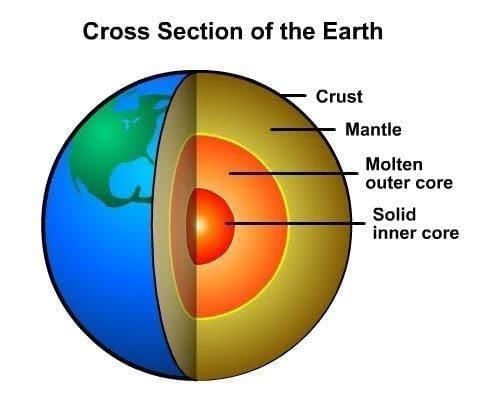
Importance of Understanding the Interior of the Earth
- Understanding the structure of the earth’s interior (crust, mantle, core) and various forces (heat, seismic waves) emanating from it is essential to understand.
- The evolution of the earth’s surface, its current shape and its future.
- The geophysical phenomenon like volcanism, earthquakes, etc.
- Earth’s magnetic field.
- The internal structure of various solar system objects.
- The evolution and present composition of the atmosphere.
- For mineral exploration.
Earth’s Surface
- Many different geological processes shape the Earth’s surface.
- The forces that cause these processes come from both above and beneath the Earth’s surface.
- Processes that are caused by forces from within the Earth are endogenous (Endo meaning “in”).
- By contrast, exogenous processes (Exo meaning “out”) come from forces on or above the Earth’s surface.
- The major geological features of the earth’s surface like mountains, plateaus, lakes are mostly a result of endogenous processes like folding, faulting that is driven by forces from inside the earth.
A Geophysical Phenomenon Like Volcanism, Earthquakes
- The forces that cause catastrophic events like earthquakes, volcanic eruptions come from deep below the earth’s surface.
- For example, earthquakes occur due to the movement of the tectonic plates and the energy required for this movement is supplied by the conventional currents in the mantle.
- Similarly, volcanism occurs through the vents and fissures created by the tectonic movements.
Earth’s Magnetic Field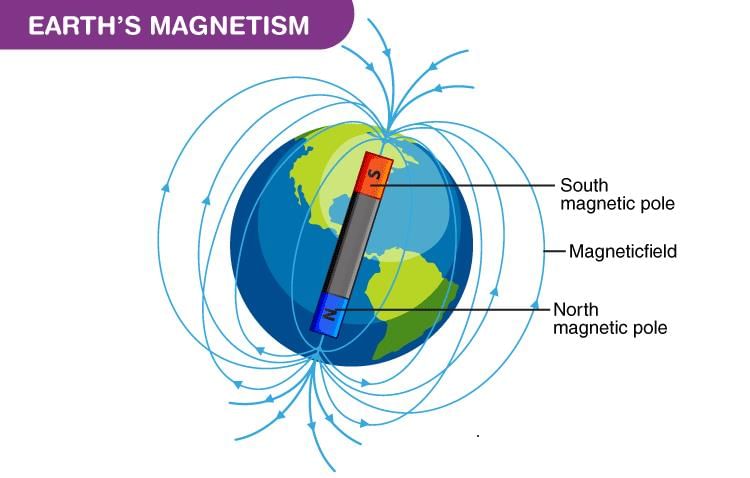
- Earth’s magnetic field is a result of convection currents in the outer core of the earth.
- Life on earth would not have been possible if not for the earth’s magnetic field which protects the earth’s atmosphere from the harmful solar wind.
Sources of Information
Most of the information about the Earth’s interior is based on inferences drawn from different sources – both direct and indirect.
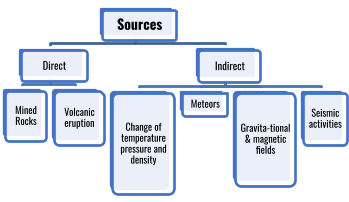
Direct Sources
- Our knowledge about the structure and interior of the earth from direct observation is very limited.
- No instrument has been invented so far which can see through the interior of the earth directly.
- The deepest depth of an oil well drilled so far is 8 kilometres. The deepest mine of the world is Robinson Deep in South Africa.
- Its depth is less than 4 kilometre. Besides mining, scientists have taken up several projects to penetrate deeper depths to explore the conditions in the crustal portions.
- Scientists world over are working on two major projects such as “Deep Ocean Drilling Project” and “Integrated Ocean Drilling Project”. The deepest drill at Kola, in the Arctic Ocean, has so far reached a depth of 12 km.
- This and many deep drilling projects have provided a large volume of information through the analysis of materials collected at different depths.
- Volcanoes are yet another major source of direct information – they tell us about the composition and characteristics of the materials found inside the Earth. However, it is difficult to ascertain the depth of the source of such material.
Indirect Sources
- The centre of the earth downward is 6,371 kilometres away from the surface of the earth. In comparison to this distance, the depth of a deep well or a mine is insignificant.
- It is, therefore, necessary to take help of indirect scientific pieces of evidence to know about the interior of the earth.
- These sources include temperature, pressure and density of the earth, the behaviour of seismic waves (the waves generated by Earthquakes), Meteors, the Moon etc.
These sources may be classified into three groups:
(a) Artificial sources such as temperature, pressure and density.
(b) Evidence from the theories of the origin of the earth
(c) Natural Sources e.g. volcanic eruption, earthquakes, meteors and seismology.
(a) Temperature
- As we dig deeper into the Earth through wells and mines, we observe an increase in temperature. This, along with the molten lava that erupts from the Earth's interior, indicates that temperatures rise as we approach the Earth's center.
- However, the increase in temperature is not consistent throughout. Within the first 100 kilometers, the temperature rises by approximately 15° to 30°C for every kilometer. This gradient decreases significantly through the mantle, increases rapidly at the bottom of the mantle, and then rises gradually in the core.
- At the base of the crust, the temperature is around 1000°C, approximately 3500°C at the bottom of the mantle, and reaches about 5000°C at the Earth's core.
- This extreme heat is primarily due to the decay of radioactive elements and chemical reactions occurring under high pressure.
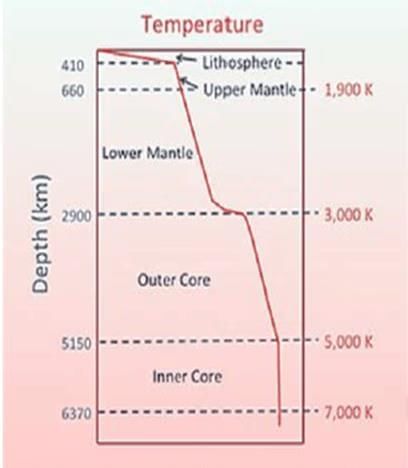
1. It is the third most abundant element in the earth crust. 2. It exists in a stable combination with other materials mainly silicates and oxides. 3. It has a high strength-to-weight ratio. Choose the answer using the code given below:
(b) Density
- The average density of the Earth's interior is approximately 5.5 g/cm³. Density increases with depth due to higher pressure and the presence of heavier materials closer to the Earth's center.
(c) Gravitation force
- The gravitation force (g) is not the same at different latitudes on the surface. It is greater near the poles and less at the equator.
- This is because of the distance from the centre at the equator being greater than that at the poles. The gravity values also differ according to the mass of material. The uneven distribution of mass of material within the earth influences this value. The reading of gravity in different places is influenced by many other factors. These readings differ from the expected values. Such a difference is called gravity anomaly.
Gravity Anomalies
- Gravity anomalies give us information about the distribution of mass of the material in the crust of the earth.
- Gravity anomalies also inform us about the distribution of molten material in the crust of the earth.
(d) Magnetic surveys
- The earth also acts like a huge magnet. The rapid spinning of the earth creates electric currents in its centre (molten outer core) that creates a magnetic field around the earth.
- The magnetic field is strongest at the magnetic north and south poles. The magnetic north and south poles do not coincide with geographic north and south poles.
- In fact, the earth’s magnetic field keeps on changing. Magnetic surveys provide information about the distribution of magnetic materials in the crustal portion, and thus, provide information about the distribution of materials in this part.
(e) Meteorites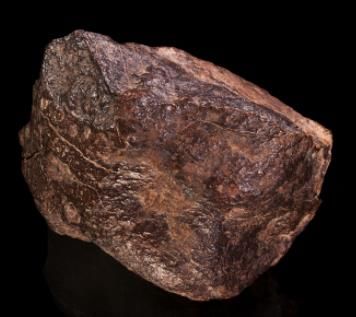 Meteorite
Meteorite
- The space debris, while entering the atmospheric layers of earth are burnt due to the friction of air.
- Only the heavier objects whose outer layers have been burnt fall to the earth. Man has discovered many such meteorites and after examining them obtained evidence about the interior of the earth.
The meteorites which have been examined are of two types:
(i) Rock; and (ii) Metals.
The metallic meteorites chiefly contain heavy materials like iron and nickel. The meteorites too have originated during the formation of the solar system. It is, therefore, very much to believe that both the meteorites and the earth are made of similar materials.Question for Interior of EarthTry yourself:Consider the following statements about the interior of the Earth:1. The continental mass of the crust is made up of silica and magnesium.
2. Crust is thicker at the ocean floors.
3. The innermost core of the Earth is made only of molten iron.
Choose the correct answer using the codes below:
View Solution
Structure of the Earth’s Interior
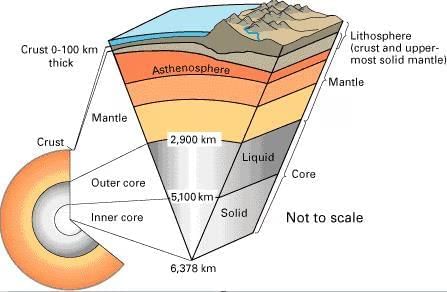
Earth is made up of several layers. According to the mechanical properties, Earth’s layers are the Lithosphere, Asthenosphere, Lower mantle (also known as mesospheric mantle), Outer core, and Inner core. Chemically, the layers are the Crust, Mantle, and Core.
The Crust
- It is the earth’s uppermost layer. The crust is solid, rigid and very thin compared with the other two.
- Like the shell of an egg, the Earth's crust is brittle and can break. The thickness of the crust is not the same everywhere.
- Oceanic crust is thinner as compared to the continental crust. The mean thickness of the oceanic crust is 5 km whereas that of the continental is around 30 km.
- The continental crust is thicker in the areas of major mountain systems. It is as much as 70 km thick in the Himalayan region.
Its main parts are
- The uppermost thin layer– It is composed of such rocks which contain a large proportion of silica and aluminium. It is called SIAL (SI = Silica, AL = Aluminum). The continents are mostly composed of sial. Its average density is 2.7 g/cm³ and thickness is of about 28 kilometres.
- The lower layer of the crust is made of comparatively heavier rocks. Silica and magnesium are the major constituents in it. This part is, therefore, known as SIMA (SI – Silicon, MA = Magnesium). The oceanic floor is also made of this rock strata. Its average thickness is 6-7 kilometres and a density of about 3.0 g/cm³. The thickness of SIAL and SIMA put together does not exceed 70 kilometres.
- Its volume is 1% of the total volume of the earth. In comparison to 6378 km radius of the earth, the thickness of 70 kilometres is insignificant. However, this cannot be overlooked. This shallow crust is the ground of nature’s wonderful activities.
1. Granitic rocks 2. Basaltic rocks 3. Pumice rocks 4. Obsidian rocks Choose the correct answer from the following codes:
The Mantle
Its thickness is about 2900 Km. Its volume is 84% of the whole earth. Near the lower limit of the crust, the velocity of P-waves increases from about 6.4 kilometres per second to 8 km per second.
- This change in velocity of P-waves indicates the surface discontinuity between the crust and the mantle. It is popularly known as Moho or the Mohorovicic discontinuity (after the name of its discoverer).
- The mantle is made up of dense and heavy materials such as oxygen, iron and magnesium. The average density of the materials in the mantle varies between 3.5 g per cubic cm and 5.5 g per cubic cm.
- The temperature of this layer ranges between 900°C and 2200° C. The temperature is quite high and the hot rocks from magma in this layer.
- The pressure of the overlying layers keeps the lower part of the crust and the upper part of the mantle in an almost solid state.
- If cracks appear in the crust, the pressure is released and the molten matter from inside the Earth tries to reach the surface through volcanic eruptions.
The upper portion of the mantle is called the asthenosphere. The word Astheno means weak. - It is considered to be extending up to 400 km. It is the main source of magma that finds its way to the surface during volcanic eruptions.
The mantle plays an important role in all the happenings in the interior of the earth. - It also gives rise to convection currents. These currents supply energy for happenings like continental drift, earthquake, volcanoes, etc.
The Core
- It extends from 2900 Km depth up to the centre of the earth (6378 km). It is the interior most of the earth. It begins from Gutenberg Discontinuity. The mantle is demarcated from the core by Gutenberg Discontinuity.
- The core is divided into two parts: (i) The Outer Core, (ii) The Inner Core.
The outer core is possibly in a wholly liquid or semi-liquid state. - The transverse or S-waves of earthquakes, seem to disappear at the Gutenberg Discontinuity.
- The outer core extends from the depth of 2900 km, up to 5150 km. It has an average density of 10 g/cm³.
- The inner core is believed to be solid. It extends from the depth of 5150 km up to the centre of the earth (6378 km).
- The velocity of P waves increases at the boundary of the outer and inner core. Its density is between 12-13. To the volume of the entire core is 16% of the earth as a whole.
- The mass of the core is 32% of the earth’s mass. The major part of the core is made up of heavy metals like iron and nickel.
- This zone is therefore known as Nife (Ni = Nickel, Fe = Ferrous). It is also known as Barysphere (which means heavy metallic rocks).
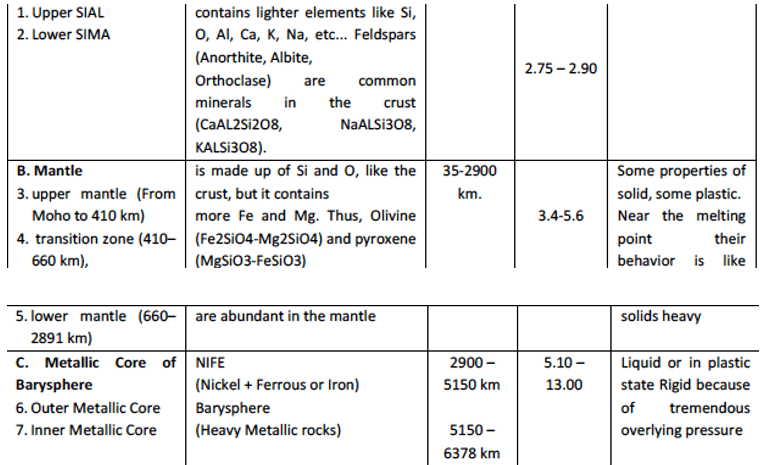
Lithosphere
The lithosphere is the solid outer layer of the Earth, made up of the crust and the upper mantle. It is located above the asthenosphere and is the coolest and most rigid of all the Earth’s layers.
- Thickness:The lithosphere has an average thickness of about 100 km, but it can reach up to 300 km beneath mountain ranges.
- Beneath the oceanic crust, the lithosphere is less than 50 km thick.
- Composition: The lithosphere is made up of large segments known as lithospheric plates or tectonic plates.
- These plates are rigid and float horizontally over the asthenosphere. Tectonic deformations occur at the boundaries of these plates due to their interactions with one another.
Asthenosphere
The asthenosphere is a layer of the Earth that is hot, soft, and mechanically weak. It is ductile and semi-viscous, consisting of semi-molten rock materials. Here are some key points about the asthenosphere:
- Properties: The asthenosphere is part of the upper mantle and is also known as the Low-Velocity Zone (LVZ). In this area, seismic waves travel more slowly, which allows lithospheric plates to float and move over the asthenosphere.
- Thickness: The average thickness of the asthenosphere ranges from 180 to 220 km.
- Depth: The asthenosphere lies below the lithosphere, starting at around 100 km deep and extending to depths of 350 to 650 km.
- Composition: The asthenosphere is primarily composed of peridotite rock, which consists mainly of the minerals olivine and pyroxene.
|
263 videos|875 docs|232 tests
|
FAQs on Interior of Earth - Geography for UPSC CSE
| 1. What is the internal structure of Earth? |  |
| 2. What is the role of the crust in the internal structure of Earth? |  |
| 3. What is the composition of the mantle? |  |
| 4. What is the significance of the Earth's core in its internal structure? |  |
| 5. How do the internal layers of Earth contribute to its overall stability? |  |





















